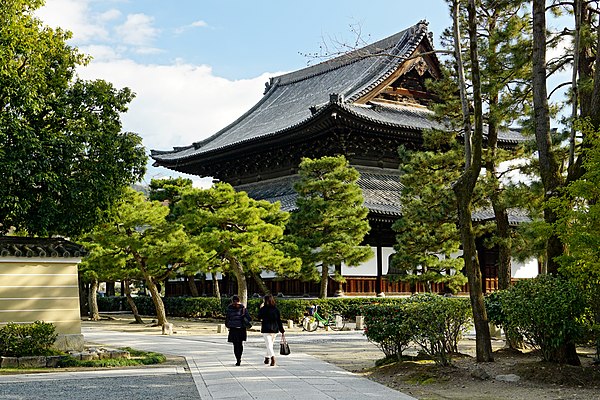

Kennin-ji
Kennin-ji is the head temple of the Kennin-ji branch of Rinzai Zen Buddhism, located in Higashiyama Ward, Kyoto City. It was founded in 1202 by Zen Master Eisai. Kennin-ji is one of the oldest Zen temples in Kyoto and houses numerous cultural assets, including the famous 'Wind and Thunder Gods' screen and the fusuma paintings by Kaihō Yūshō. The temple grounds feature beautiful gardens and historic buildings, with the ceiling of the Dharma Hall adorned with the impressive 'Twin Dragons' painting as a highlight. Additionally, Kennin-ji offers zazen meditation and sutra copying experiences, allowing visitors to immerse themselves in the Zen spirit. Kennin-ji was established in 1202 by Zen Master Eisai, who played a key role in spreading Zen Buddhism in Japan, making Kennin-ji the center of his activities. Originally founded as a Tendai sect temple, it later converted to the Rinzai sect. Throughout the Muromachi and Edo periods, Kennin-ji underwent numerous repairs and reconstructions. During the Muromachi period, it was under the patronage of the Ashikaga shogunate, receiving many cultural treasures. In the Edo period, Tokugawa Ieyasu undertook extensive restorations, and many of the current buildings date from this time. Important structures on the temple grounds include the Dharma Hall, the Abbot's Quarters, and the Sanmon Gate, each with significant historical value. Kennin-ji is also closely associated with the tea ceremony, as Zen Master Eisai introduced tea to Japan, contributing to the development of tea culture. Kennin-ji not only holds historical significance but also attracts many tourists with its beautiful gardens and cultural assets. The highlights of Kennin-ji include: Gardens: Daiou-en: Located in front of the Abbot's Quarters, this dry landscape garden features beautifully arranged white sand, moss, and large rocks, providing a serene atmosphere to experience Zen. Chouon-tei: A four-sided garden that offers beautiful views from all directions, with exquisite arrangements of moss and stones that reflect the changing seasons. Maru-Sankaku-Shikaku Garden: This garden represents Zen philosophy, where the circle symbolizes water, the square symbolizes earth, and the triangle symbolizes fire. The central Kamejima (Turtle Island) and the ripple patterns in the stone garden are distinctive features. Cultural Assets: Wind and Thunder Gods Folding Screen: A national treasure painted by Tawaraya Sōtatsu, this iconic piece depicts the powerful figures of the Wind God and Thunder God.Twin Dragons: Painted on the ceiling of the Dharma Hall to commemorate the temple's 800th anniversary in 2002, this gigantic artwork covers an area equivalent to 108 tatami mats and is awe-inspiring. Other notable experiences include zazen meditation and sutra copying. At Kennin-ji, visitors can participate in zazen to directly experience Zen practice, or engage in sutra copying in a tranquil setting, calming the mind.Kennin-ji is a place where history, culture, and natural beauty blend harmoniously.